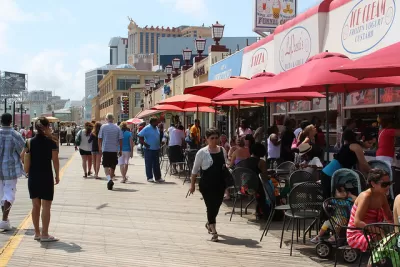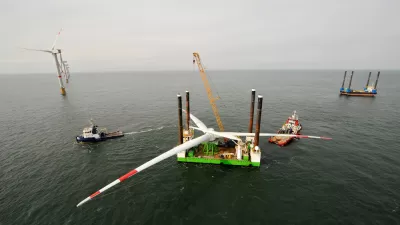Atlantic City, New Jersey, has been down on its luck lately. But, in the wake of Superstorm Sandy, AC could become the ideal laboratory for developing technologies and practices to help coastal cities build resiliency in the face of climate change.

One of the biggest problems with urban resiliency is that it's hard to test what works and what doesn't. Engineers can't create hurricanes or tidal flooding, and they can't build entire cities to see what happens. Or can they?
As one of the objects of Superstorm Sandy's wrath—not to mention other storms and hurricanes—Atlantic City, New Jersey, already has plenty of experience with coastal hazards. And, as the climate changes and seas rise, it's expecting to experience a lot more. The decline of gambling and tourism has left Atlantic City in a financially and ecologically precarious position.
All of this, according to a new proposal from the architecture firm Perkins+Will, makes Atlantic City an ideal place to study coastal hazards and develop techniques and technologies to combat them. The proposal envisions a nearly total transformation of the city into a research "campus." While much scientific research takes place in expensive cities like Boston and San Diego, the proposal's authors note that AC's vacant casinos can provide cheap housing for teams of scientists and engineers who can turn casino floors into enormous labs. Places that once sucked gamblers' wallets dry can help cities avoid being submerged.
"If somebody wanted to test structures being able to withstand flooding or wind, you could imagine creating a wind tunnel or some sort of floodable space," Perkins+Will senior urban designer planner Daniel Windsor told Fast Company. "Or if it's about emergency response, you can imagine creating these large-scale command center simulators where people can come in and train on software or large command-center-like simulations."
Perkins+Will created the proposal entirely on spec, without a public- or private-sector client, as a thought experiment. The Fast Company article does not quote any city officials, so the proposal remains speculative at best.
"In Atlantic City's case, the pitch for a resiliency-first redesign was a matter of timing. Windsor says the P+W task force had monitored issues like wildfires in Northern California, drought in Southern California, and sea-level rise on the East Coast before settling on Atlantic City for its first full-fledged resiliency showcase....Windsor likens Atlantic City—which spans about 4 square miles—to a college campus. And it's not an accidental comparison: Perkins+Will imagines academic institutions working alongside government agencies and scientists in its utopian A.C."
"We're hoping that this furthers the dialogue and that we can start to work with people in Atlantic City to help diversify the economy and potentially integrate some of these strategies and work with institutions and things like that," Windsor says. "Right now, it's an idea, and we're hoping that it becomes more."
FULL STORY: Could Atlantic City Become an Innovation Hub for Climate Change and Resiliency?

Alabama: Trump Terminates Settlements for Black Communities Harmed By Raw Sewage
Trump deemed the landmark civil rights agreement “illegal DEI and environmental justice policy.”

Study: Maui’s Plan to Convert Vacation Rentals to Long-Term Housing Could Cause Nearly $1 Billion Economic Loss
The plan would reduce visitor accommodation by 25% resulting in 1,900 jobs lost.

Why Should We Subsidize Public Transportation?
Many public transit agencies face financial stress due to rising costs, declining fare revenue, and declining subsidies. Transit advocates must provide a strong business case for increasing public transit funding.

Paris Bike Boom Leads to Steep Drop in Air Pollution
The French city’s air quality has improved dramatically in the past 20 years, coinciding with a growth in cycling.

Why Housing Costs More to Build in California Than in Texas
Hard costs like labor and materials combined with ‘soft’ costs such as permitting make building in the San Francisco Bay Area almost three times as costly as in Texas cities.

San Diego County Sees a Rise in Urban Coyotes
San Diego County experiences a rise in urban coyotes, as sightings become prevalent throughout its urban neighbourhoods and surrounding areas.
Urban Design for Planners 1: Software Tools
This six-course series explores essential urban design concepts using open source software and equips planners with the tools they need to participate fully in the urban design process.
Planning for Universal Design
Learn the tools for implementing Universal Design in planning regulations.
Smith Gee Studio
Alamo Area Metropolitan Planning Organization
City of Santa Clarita
Institute for Housing and Urban Development Studies (IHS)
City of Grandview
Harvard GSD Executive Education
Toledo-Lucas County Plan Commissions
Salt Lake City
NYU Wagner Graduate School of Public Service





























